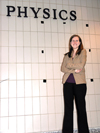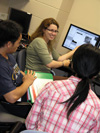Stories from...2011
 New Center for Agricultural, Biomedical, and Pharmaceutical Nanotechnology (CABPN) To Target Biotechnology
New Center for Agricultural, Biomedical, and Pharmaceutical Nanotechnology (CABPN) To Target Biotechnology
February 10, 2011
The new Center for Agricultural, Biomedical, and Pharmaceutical Nanotechnology (CABPN) is an NSF Industry/University Cooperative Research Center designed to enable discovery and innovation through collaboration. CABPN's mission is to conduct industrially-relevant fundamental research into applications of nanotechnology in the fields of drug development, agriculture, and medical technology; to facilitate technology transfer to industry; and to enhance graduate education and research.
FULL STORY
 STEM Pipeline Alive and Well as Science Olympiad Impacts
STEM Pipeline Alive and Well as Science Olympiad Impacts
Former Contestant's STEM Career Choice
May 25, 2011
GET YOUNGSTERS HOOKED ON STEM when they're young, and when they're old, they'll choose STEM careers! Theoretically, that's how the STEM (science, engineering, technology and/or mathematics) pipeline is supposed to work, and Dr. Jennifer Docktor's journey along the pipeline is a perfect example. She began her voyage by getting involved in Science Olympiad at the age of 12 and credits her years in the science competition as playing a big part in her decision to enter the field of physics education.
STORY
 iRISE Workshop is a Hit With Local Middle School Teachers
iRISE Workshop is a Hit With Local Middle School Teachers
June 28, 2011
On Tuesday, June 28th, 2011, 24 middle school teachers from across the state came to the University of Illinois to build algae bioreactors, take apart and reassemble computers, build chemical and mechanical water filters, and explore the fluorescence of living plants. These activities were developed into classroom-ready lesson materials by a group of graduate students, faculty, and veteran teachers as part of the iRISE Project.
STORY
 Amos's Atomic Microscope Gives Students Close-Up Look at Cells
Amos's Atomic Microscope Gives Students Close-Up Look at Cells
August 26, 2011
A few adventurous young bioengineers are taking cell research to a whole new level—the atomic level. University of Illinois bioengineering students now have access to a new tool for looking at cells called an Atomic Force Microscope (AFM). In March, the Roy J. Carver Charitable Trust provided the $290,000 machine, in the form of a grant, to the university and to bioengineering lecturer Jennifer Amos. Amos will lead a new class this fall called “The Bioreactor Lab” that will focus on teaching students about the use Atomic Force Microscopy in bioengineering.
STORY













.jpg)
















